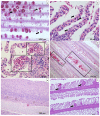Prospective Longitudinal Study of Putative Agents Involved in Complex Gill Disorder in Atlantic salmon (Salmo salar)
- PMID: 36014998
- PMCID: PMC9415954
- DOI: 10.3390/pathogens11080878
Prospective Longitudinal Study of Putative Agents Involved in Complex Gill Disorder in Atlantic salmon (Salmo salar)
Abstract
Complex gill disorder (CGD) is an important condition in Atlantic salmon aquaculture, but the roles of the putative aetiological agents in the pathogenesis are uncertain. A longitudinal study was undertaken on two salmon farms in Scotland to determine the variations in loads of CGD-associated pathogens (Desmozoon lepeophtherii, Candidatus Branchiomonas cysticola, salmon gill pox virus (SGPV) and Neoparamoeba perurans) estimated by quantitative PCR. In freshwater, Ca. B. cysticola and SGPV were detected in both populations, but all four pathogens were detected on both farms during the marine stage. Candidatus B. cysticola and D. lepeophtherii were detected frequently, with SGPV detected sporadically. In the marine phase, increased N. perurans loads associated significantly (p < 0.05) with increases in semi-quantitative histological gill-score (HGS). Increased Ca. B. cysticola load associated significantly (p < 0.05) with increased HGS when only Farm B was analysed. Higher loads of D. lepeophtherii were associated significantly (p < 0.05) with increased HGS on Farm B despite the absence of D. lepeophtherii-type microvesicles. Variations in SGPV were not associated significantly (p > 0.05) with changes in HSG. This study also showed that water temperature (season) and certain management factors were associated with higher HGS. This increase in histological gill lesions will have a deleterious impact on fish health and welfare, and production performance.
Keywords: Candidatus Branchiomonas cysticola; Desmozoon lepeophtherii; Neoparamoeba perurans; Paranucleospora theridion; amoebic gill disease; aquatic animals; complex gill disease; emerging diseases; pathogens; salmon gill poxvirus.
Conflict of interest statement
The authors declare no conflict of interest.
Figures











Similar articles
-
Investigation of co-infections with pathogens associated with gill disease in Atlantic salmon during an amoebic gill disease outbreak.J Fish Dis. 2018 May 27. doi: 10.1111/jfd.12814. Online ahead of print. J Fish Dis. 2018. PMID: 29806080
-
Complex Gill Disease: an Emerging Syndrome in Farmed Atlantic Salmon (Salmo salar L.).J Comp Pathol. 2018 Aug;163:23-28. doi: 10.1016/j.jcpa.2018.07.004. Epub 2018 Aug 16. J Comp Pathol. 2018. PMID: 30213370 Review.
-
A cohort study of gill infections, gill pathology and gill-related mortality in sea-farmed Atlantic salmon (Salmo salar L.): A descriptive analysis.J Fish Dis. 2022 Sep;45(9):1301-1321. doi: 10.1111/jfd.13662. Epub 2022 Jun 16. J Fish Dis. 2022. PMID: 35707921 Free PMC article.
-
Multi-agent in situ hybridization confirms Ca. Branchiomonas cysticola as a major contributor in complex gill disease in Atlantic salmon.Fish Shellfish Immunol Rep. 2021 Sep 6;2:100026. doi: 10.1016/j.fsirep.2021.100026. eCollection 2021 Dec. Fish Shellfish Immunol Rep. 2021. PMID: 36420507 Free PMC article.
-
Salmon gill poxvirus, a recently characterized infectious agent of multifactorial gill disease in freshwater- and seawater-reared Atlantic salmon.J Fish Dis. 2017 Oct;40(10):1253-1265. doi: 10.1111/jfd.12608. Epub 2017 Jan 20. J Fish Dis. 2017. PMID: 28105681 Review.
Cited by
-
Effectiveness of functional ingredients to enhance gill disease in Atlantic salmon (Salmo salar, L.).PLoS One. 2024 Jun 20;19(6):e0304112. doi: 10.1371/journal.pone.0304112. eCollection 2024. PLoS One. 2024. PMID: 38900829 Free PMC article.
-
Diseases of marine fish and shellfish in an age of rapid climate change.iScience. 2024 Aug 28;27(9):110838. doi: 10.1016/j.isci.2024.110838. eCollection 2024 Sep 20. iScience. 2024. PMID: 39318536 Free PMC article. Review.
-
A novel high-throughput qPCR chip for solving co-infections in RAS farmed rainbow trout.Sci Rep. 2024 Jul 22;14(1):16802. doi: 10.1038/s41598-024-65697-8. Sci Rep. 2024. PMID: 39039114 Free PMC article.
-
Precision farming in aquaculture: assessing gill health in Atlantic salmon (Salmo salar) using a non-invasive, AI-driven behavioural monitoring approach in commercial farms.Aquac Sci Manag. 2025;2(1):15. doi: 10.1186/s44365-025-00020-8. Epub 2025 Aug 15. Aquac Sci Manag. 2025. PMID: 40851784 Free PMC article.
References
-
- Boerlage A.S., Ashby A., Herrero A., Reeves A., Gunn G.J., Rodger H.D. Epidemiology of marine gill diseases in Atlantic salmon (Salmo salar) aquaculture: A review. Rev. Aquac. 2020;12:2140–2159. doi: 10.1111/raq.12426. - DOI
-
- Sommerset I., Bang Jensen B., Bornø B., Haukaas A., Brun E. The Health Situation in Norwegian Aquaculture 2020. [(accessed on 9 July 2022)]. Available online: https://www.vetinst.no/rapporter-og-publikasjoner/rapporter/2021/fish-he....
-
- Rodger H.D. Amoebic gill disease (AGD) in farmed salmon (Salmo salar) in Europe. Fish Vet. J. 2014;14:16–27.
Grants and funding
LinkOut - more resources
Full Text Sources
Medical

